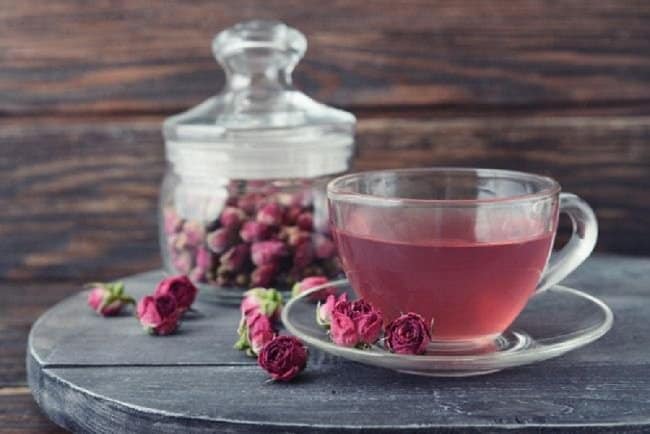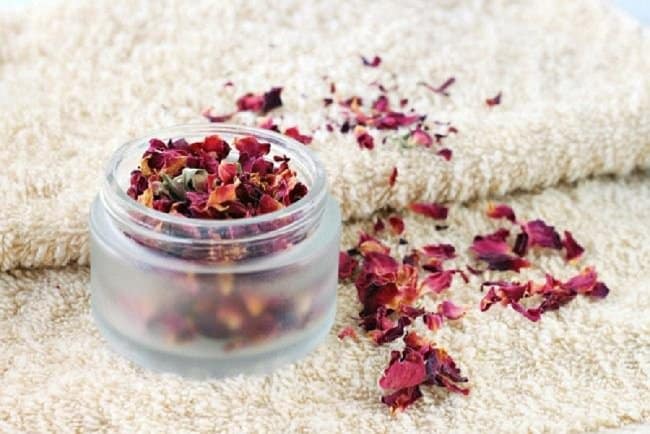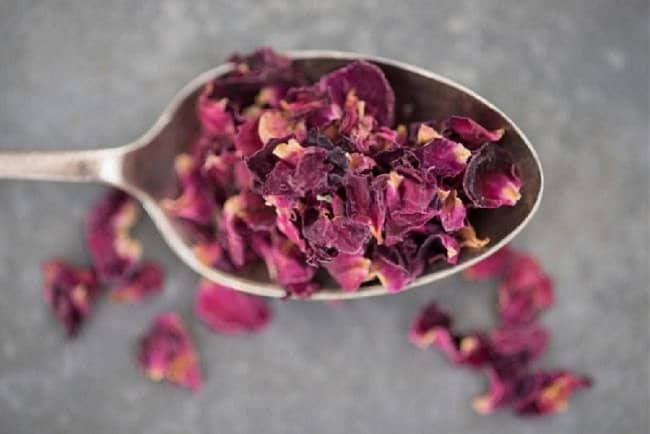Rose petals are entirely edible and you can dry rose petals, to make the most light and refreshing tea. I LOVE rose tea in the summertime especially. Add scones with rose petal jam and pretty tea cups and I’m on my way to having a super-decadent afternoon! If you’re going to make your own tea from scratch, you’ll most likely want to use dried rose petals, not fresh – dried rose petals can last for 1-3 years if stored properly, and look super pretty too!

- Book-drying
- Sun or air drying
- Using a conventional oven
- Using a microwave
- Using a dehydrator
Using a dehydrator is probably the best method for drying rose petals for tea as it helps the petals retain their color, shape, and all the essential vitamins in the petals – essential if you want pretty, ‘grammable tea!
The best natural method to dry rose petals for tea is sun or air drying; it’s natural, fast, and easy. Plus you can also make pretty mandalas with the petals while you lay them out, which is a beautifully calming and meditative activity if you have a some time spare and want to slow down a little.
Microwaves might be adding infra-red waves to your petals, and while they’re not proven to be harmful, I like to be on the cautious side and never use a microwave for anything!
Table of Contents
The Best Methods For Drying Rose Petals For Tea
There are several ways you can employ to dry out your rose petals, whether you immediately plan to use them in your cup of afternoon tea, or preserve them in your pantry for future use.
Using an old book
I am confident that, at some point, we have all dried flower petals inside book pages, especially as children. Coming home with picked yellow dandelions we wanted to preserve, or a particularly exciting leaf we found under a tree, drying out plants in a book is a method our parents and biology teachers lovingly taught us!
One of the things I love most about drying rose petals for tea in this way is that sense of nostalgia it brings.
- Find a good, big, preferably old book to use as your pressing medium. Choose one that you won’t miss, as this process isn’t always non-destructive towards the book. Older books tend to have coarse pages that are better at absorbing moisture from plants than glossy pages that many new books have.
- Pressing plants in a book works in such a way that you place a plant between two pages of the book and let gravity and pressure do the work for you. Place petals evenly on the pages. Make sure you space them out sufficiently.
- If you have many petals to press, ensure to have at least several pages distance between your layers of pressings. This is to make sure that there are enough pages to properly absorb moisture and dry out the petals.
- Stack more heavy books on your book with petals and allow it to settle for about 2 to 3 weeks. This should be enough time to get brittle, thin, and even petal pressings.
Air-drying / Sun-drying
This is yet another simple method in which you allow a medium to do your work for you. In this particular case, it is a beautiful combination of fresh air and sunlight. This works exceptionally well in summer months, or if you have an undisturbed, flat spot somewhere indoors that sits nicely in full sunlight. A sunny window works well.
- Acquire two wire mesh dryers/drying screens. They are wire mesh screens that are reminiscent of a tense mosquito net in a frame. Among other uses, they are especially useful at keeping bugs at bay from disturbing the process. Ants and bees will undoubtedly be attracted by the scent of your drying rose petals.
- Lay out one drying screen onto a flat, stable surface.
- Spread out petals onto the drying screen, taking care to spread them sufficiently far apart from each other in one layer, avoiding mutual overlapping.
- Cover the petals with the other drying screen.
- Leave out in the sunlight for about 30 minutes. Turn the petals around every 10 minutes.
- Once you notice the petals becoming dry and brittle to the touch and they have shrunken and darkened in color, remove and store in a mason jar or other airtight container.
How To Dry Rose Petals In An Oven
For those of you impatient for your afternoon cup of tea, I have some very good news! You can use your regular, run-of-the-mill kitchen oven to dry your rose petals quite fast.
- Take a shallow oven baking tray and line with parchment paper.
- Preheat the over to 50 degrees Celsius or 120 degrees Fahrenheit.
- Sprinkle rose petals onto parchment paper. Spread them far enough apart so that they’re not touching, in a single layer. Make sure petals aren’t overlapping.
- Place the baking tray into the oven and bake for 1 hour or until the petals have dried out.
- Check the state of your petals once every 15 minutes and make sure to rotate them.
- When rose petals get delicate and crunchy to the touch, or have otherwise lost moisture to a degree you deem satisfactory, take them out and store in a bowl to cool down.
Using A Microwave Oven
Fortunately, if you have a microwave, you can get great results even faster than in a conventional oven. This method is renowned for doing the best when it comes to preserving color in dried petals.
- Line a microwave-safe plate with a layer of paper towels.
- Place your rose petals onto the plate onto a paper towel.
- Cover the rose petals with another layer of paper towels. Place another microwave-safe plate over it to act as a barrier.
- Place into microwave for 40 seconds. Take it out every 15 seconds and rotate or stir the petals around.
- Extend time in microwave as necessary by 15 seconds at a time to reach desired degree of dryness.
Using A Dehydrator For Rose Petals
A dehydrator is a specialty device used to rid food of moisture to aid in its preservation. It happens to do equally well when you simply want to dry rose petals for tea. Depending on whether your dehydrator is mechanical or electronic, instructions may vary. Automatic dehydrators also might differ in instruction, but all follow a similar way of use.
- Distribute rose petals evenly across the built-in drying rack. Just like in other methods, avoid overlap and multilayering and give them space away from each other.
- Adjust the dehydrator to work at the lowest possible setting. Depending on which brand or type you are using, dehydrating the petals might take you from several hours up to 24 hours.
- Leave the petals to dry, making sure to rotate them every 30 minutes. Watch out for any signs of burning, browning or coal-forming (unless that is your goal).
- After you have dried petals to your preference, carefully remove them from the rack and store them at a dry and cool place.
Honorable mention goes out to the method of freeze-drying. However, I will not be covering it here, as it is not a safe, convenient or an inexpensive home method. Rather, it is something that you should leave to professionals.
Preparing Rose Petals For Drying
So now you’ve picked your selected method for drying your rose petals, you’ll need to prepare your roses.
Many producers nowadays offer unique blends of organic dry rose petals that you can buy and use for tea. You may choose to do this, and follow the instructions on the label.
However, if you have a rose plant that is in its maturity with flowers in full bloom, a natural choice might be to try your hand at drying your own rose petals at home.
How To Harvest Rose Petals For Tea
Collect fresh and organically grown rose flowers. You are the safest picking from your own rose bush, as you can always vouch for the conditions you grew your rose under.
If you are drying rose petals for decoration purposes, it might not be that important to trace whether its origins are organic or not. However, you need to exercise caution if you plan on using these rose petals in tea!
Only use strictly organic petals or rose stems, as the last thing you want in your tea is a dose of pesticide!
Choose rose flowers that are in full bloom or slightly past that point. You want to make sure that the rose petals aren’t already brown, as the process of drying rose petals for tea will only turn them browner.
Look for flowers where petals are a slight bit looser, or the flower head is slightly more open than at prime bloom time. If there are still blooms that didn’t form fully yet, skip them and allow them to get to this stage before picking the petals.
Use high-octane flowers and blooms with intense colors for best effect – taste-wise, effect-wise, and aesthetic-wise.
How to pick petals without damaging the plant
Pick off petals straight from the white base – they will come right off with minimal force if you lightly pull upwards to detach. Frequently, rose petals are already dry while still on the bush, especially if you’re lucky enough to live somewhere with long hot summers!
Alternatively, you may choose to cut off the blooms as if you are harvesting roses for a bouquet. In that case, mind to thoroughly remove the stem part from the flowers. Stem of a rose plant is generally known to be quite bitter-tasting and can offset the fruity taste of the tea.
Generally, the best time to pick rose flowers for tea is in the morning, after dew on the petals dries. This prevents moisture from browning petals when they’re dried, but roses are also known to be sweetest and most fragrant in the morning hours.
Make sure to thoroughly wash your rose petals by placing them in a sieve and running them through a gentle stream of water over the sink. Turn them and rinse them out using your hands to make sure they’re free of dirt, debris, or dew.
The Best Way To Store Dried Rose Petals
After all that hard working making your beautiful petals ready for your tea, you’re going to want to know the best way to store them. Storing them properly ensures they last their full shelf-life (1-3 years) and stay mould and decay free. After all, you most likely don’t want mould residue in your pretty petal tea!
To store dried rose petals properly, you’ll need to
- Ensure your petals are clean and free of any moisture before storing
- Keep petals in an airtight container such as a lidded mason jar
- Ensure the jar is kept out of direct sunlight
- Store your rose petal jar in a cool, dry place
- Check on your rose petals weekly to check for signs of mould
- Discard petals with mould signs (it’s ok to keep the rest)
Other uses for dry rose petals
The whole point of making and preserving dry rose petals doesn’t exclusively have to be for tea, as beneficial for your health as it is.
You can easily add dried rose petals to salads of your choice. Additionally, you may choose to preserve them for aesthetic purposes in glycerin, in frames or mason jars as standalone herbariums.
Dried rose petals are an important ingredient in a prized treat tracing its origins from the Middle East. Middle Easterners call it gulkand, and they make it exclusively of rose petal preserve and sugar. It is sweet and very caloric, originating from the Indian subcontinent, where it also got its name (gul = flower; kand = sweet).
Rose petals are also a common spice, appearing in many dishes native to the Middle East. They are also a common ingredient in potpourri. Potpourri is a mixture of dried, fragrant plant materials used in bowls as decoration and source of pleasant smell within the household.
They might serve edible and decorative purpose on various cakes, or be an unmissable part of cult cocktails. It is quite simple to make rose water out of dried petals, as well, by infusing them with warm water.
You may also be surprised to find them as a common ingredient in care products. Chemists use them abundantly, especially in tonics and face scrubs, as they are filled to the brim with vitamins and antioxidants which play their tentative part in keeping the skin fresh.
Interestingly, you can also find dried petals in an exotic spice called “Ras el hanout“. Ras el hanout is a mix, originating all the way from Morocco, spanning 20 or more spices blended together. In literal translation, “Ras el hanout” means “The chief of the store”. It is usually the most exquisite blend of the most high-quality ingredients that the spice store-owner has to offer. That definitely serves as a great tip-off on the importance and vastness of the positive effects of rose petals.
Therefore, don’t be afraid, and if you have a rose variety undergoing full flower maturity, be sure to give some of the more convenient methods a try!
If you enjoyed learning how to dry your rose flowers and petals for tea, click here for our best rose petal tea recipes!







